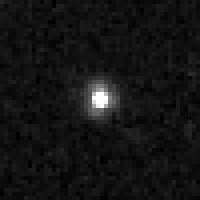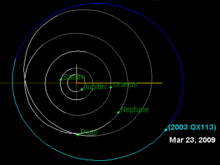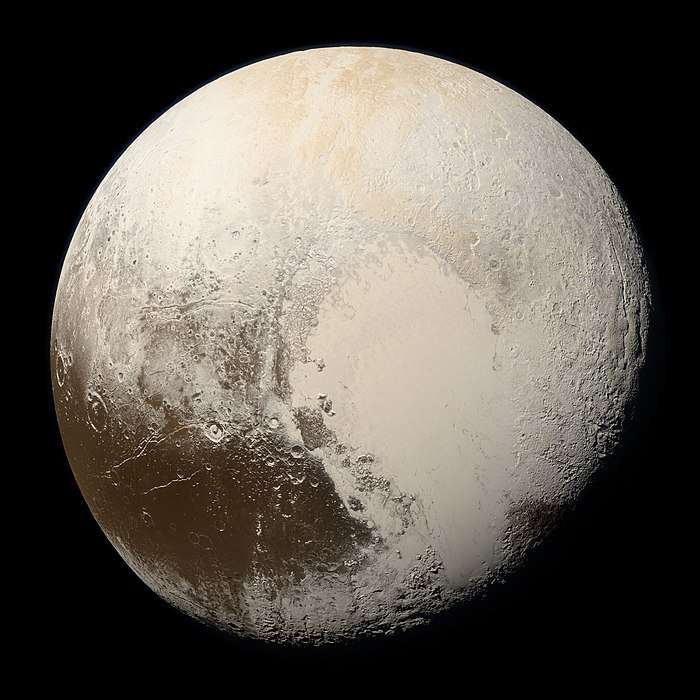2003 QX113
2003 QX113, also written as 2003 QX113, is a detached object[2] that was discovered when it was near aphelion. With an absolute magnitude of 4.7,[3] it may be a dwarf planet.[6] This has an orbit in the Kuiper belt region, home to the dwarf Planet Pluto, however this body has an even more eccentric orbit than Pluto.
 Hubble Space Telescope image of 2003 QX113 taken in 2006 | |
| Discovery[1] | |
|---|---|
| Discovery date | 2003 |
| Designations | |
| 2003 QX113 | |
| Detached object[2] | |
| Orbital characteristics[3] | |
| Epoch 13 January 2016 (JD 2457400.5) | |
| Uncertainty parameter 5 | |
| Observation arc | 1778 days (4.87 yr) |
| Aphelion | 62.146 AU (9.2969 Tm) (Q) |
| Perihelion | 36.750 AU (5.4977 Tm) (q) |
| 49.448 AU (7.3973 Tm) (a) | |
| Eccentricity | 0.25680 (e) |
| 347.72 yr (127,004 d) | |
| 136.84° (M) | |
| 0° 0m 10.205s / day (n) | |
| Inclination | 6.7751° (i) |
| 158.07° (Ω) | |
| 25.042° (ω) | |
| Earth MOID | 35.7537 AU (5.34868 Tm) |
| Jupiter MOID | 31.3004 AU (4.68247 Tm) |
| Physical characteristics | |
| Dimensions | 505 km (assumed)[4] |
| 0.09 (assumed) | |
| 22.6[5] | |
| 4.7[3] | |
As of February 2016 located 59.9 AU from the Sun,[7] it will have moved beyond 60 AU by 2017 and will reach its aphelion around 2058.[8] It last came to perihelion around 1883.[3] Its current distance makes it one of the twelve most distant known minor planets in the Solar System (see table below).[7]
Size estimate
When 2003 QX113 was first discovered, it was estimated to have an absolute magnitude (H) of 4.9,[1] giving it an assumed size of only 461 kilometres (286 mi) in diameter.[4] As of 2010, 2003 QX113 is estimated to have a brighter absolute magnitude (H) of 4.7.[3] Assuming it is a trans-Neptunian object with a generic albedo of 0.09, it is about 505 kilometres (314 mi) in diameter.[4]
It has been observed 23 times over six oppositions and has an orbit quality of 4.[3]
See also
- List of Solar System objects most distant from the Sun in 2015
- (148209) 2000 CR105
- Eris (dwarf planet)
References
- Marsden, Brian G. (22 April 2006). "MPEC 2006-H29 : 45 NEW MULTIPLE-OPPOSITION TNOs". IAU Minor Planet Center. Harvard-Smithsonian Center for Astrophysics. Retrieved 6 January 2010.
- Marc W. Buie. "Orbit Fit and Astrometric record for 03QX113" (last observation: 2008-05-05 using 23 of 23 observations over 4.87 years). SwRI (Space Science Department). Retrieved 23 March 2009.
- "JPL Small-Body Database Browser: (2003 QX113)" (last observation: 2008-05-05; arc: 4.87 years). Retrieved 30 March 2016.
- Wm. Robert Johnston (22 August 2008). "List of Known Trans-Neptunian Objects". Johnston's Archive. Archived from the original on 18 April 2009. Retrieved 23 March 2009.
- "AstDyS 2003QX113 Ephemerides". Department of Mathematics, University of Pisa, Italy. Archived from the original on 14 May 2009. Retrieved 23 March 2009.
- "How many dwarf planets are there in the outer solar system?". Gps.caltech.edu. 21 July 2015. Archived from the original on 18 October 2011. Retrieved 22 July 2015.
- "List of minor planets more than 57.0 AU from the Sun". AstDyS-2, Asteroids – Dynamic Site, Department of Mathematics, University of Pisa, Italy. Retrieved 13 December 2018.
- "Horizon Online Ephemeris System". California Institute of Technology, Jet Propulsion Laboratory. Retrieved 23 March 2009.
External links
- What is the most distant body in the Solar System? A historical view (Michael Richmond)
- 2003 QX113 at AstDyS-2, Asteroids—Dynamic Site
- 2003 QX113 at the JPL Small-Body Database

_(cropped).jpg)
